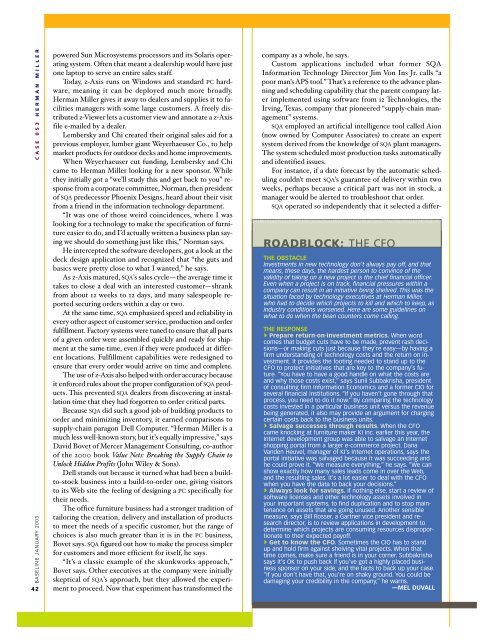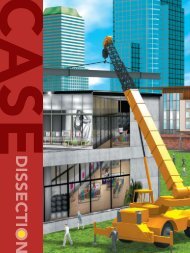Herman Miller
Herman Miller
Herman Miller
Create successful ePaper yourself
Turn your PDF publications into a flip-book with our unique Google optimized e-Paper software.
CASE 053 HERMAN MILLER<br />
BASELINE JANUARY 2003<br />
42<br />
powered Sun Microsystems processors and its Solaris operating<br />
system. Often that meant a dealership would have just<br />
one laptop to serve an entire sales staff.<br />
Today, z-Axis runs on Windows and standard PC hardware,<br />
meaning it can be deployed much more broadly.<br />
<strong>Herman</strong> <strong>Miller</strong> gives it away to dealers and supplies it to facilities<br />
managers with some large customers. A freely distributed<br />
z-Viewer lets a customer view and annotate a z-Axis<br />
file e-mailed by a dealer.<br />
Lembersky and Chi created their original sales aid for a<br />
previous employer, lumber giant Weyerhaeuser Co., to help<br />
market products for outdoor decks and home improvements.<br />
When Weyerhaeuser cut funding, Lembersky and Chi<br />
came to <strong>Herman</strong> <strong>Miller</strong> looking for a new sponsor. While<br />
they initially got a “we’ll study this and get back to you” response<br />
from a corporate committee, Norman, then president<br />
of SQA predecessor Phoenix Designs, heard about their visit<br />
from a friend in the information technology department.<br />
“It was one of those weird coincidences, where I was<br />
looking for a technology to make the specification of furniture<br />
easier to do, and I’d actually written a business plan saying<br />
we should do something just like this,” Norman says.<br />
He intercepted the software developers, got a look at the<br />
deck design application and recognized that “the guts and<br />
basics were pretty close to what I wanted,” he says.<br />
As z-Axis matured, SQA’s sales cycle—the average time it<br />
takes to close a deal with an interested customer—shrank<br />
from about 12 weeks to 12 days, and many salespeople reported<br />
securing orders within a day or two.<br />
At the same time, SQA emphasized speed and reliability in<br />
every other aspect of customer service, production and order<br />
fulfillment. Factory systems were tuned to ensure that all parts<br />
of a given order were assembled quickly and ready for shipment<br />
at the same time, even if they were produced at different<br />
locations. Fulfillment capabilities were redesigned to<br />
ensure that every order would arrive on time and complete.<br />
The use of z-Axis also helped with order accuracy because<br />
it enforced rules about the proper configuration of SQA products.<br />
This prevented SQA dealers from discovering at installation<br />
time that they had forgotten to order critical parts.<br />
Because SQA did such a good job of building products to<br />
order and minimizing inventory, it earned comparisons to<br />
supply-chain paragon Dell Computer. “<strong>Herman</strong> <strong>Miller</strong> is a<br />
much less well-known story, but it’s equally impressive,” says<br />
David Bovet of Mercer Management Consulting, co-author<br />
of the 2000 book Value Nets: Breaking the Supply Chain to<br />
Unlock Hidden Profits (John Wiley & Sons).<br />
Dell stands out because it turned what had been a buildto-stock<br />
business into a build-to-order one, giving visitors<br />
to its Web site the feeling of designing a PC specifically for<br />
their needs.<br />
The office furniture business had a stronger tradition of<br />
tailoring the creation, delivery and installation of products<br />
to meet the needs of a specific customer, but the range of<br />
choices is also much greater than it is in the PC business,<br />
Bovet says. SQA figured out how to make the process simpler<br />
for customers and more efficient for itself, he says.<br />
“It’s a classic example of the skunkworks approach,”<br />
Bovet says. Other executives at the company were initially<br />
skeptical of SQA’s approach, but they allowed the experiment<br />
to proceed. Now that experiment has transformed the<br />
company as a whole, he says.<br />
Custom applications included what former SQA<br />
Information Technology Director Jim Von Ins Jr. calls “a<br />
poor man’s APS tool.” That’s a reference to the advance planning<br />
and scheduling capability that the parent company later<br />
implemented using software from i2 Technologies, the<br />
Irving, Texas, company that pioneered “supply-chain management”<br />
systems.<br />
SQA employed an artificial intelligence tool called Aion<br />
(now owned by Computer Associates) to create an expert<br />
system derived from the knowledge of SQA plant managers.<br />
The system scheduled most production tasks automatically<br />
and identified issues.<br />
For instance, if a date forecast by the automatic scheduling<br />
couldn’t meet SQA’s guarantee of delivery within two<br />
weeks, perhaps because a critical part was not in stock, a<br />
manager would be alerted to troubleshoot that order.<br />
SQA operated so independently that it selected a differ-<br />
21185136467523256485195635736354485932643456395465306577367561254362745792315<br />
ROADBLOCK: THE CFO<br />
THE OBSTACLE<br />
Investments in new technology don’t always pay off, and that<br />
means, these days, the hardest person to convince of the<br />
validity of taking on a new project is the chief financial officer.<br />
Even when a project is on track, financial pressures within a<br />
company can result in an initiative being shelved. This was the<br />
situation faced by technology executives at <strong>Herman</strong> <strong>Miller</strong>,<br />
who had to decide which projects to kill and which to keep, as<br />
industry conditions worsened. Here are some guidelines on<br />
what to do when the bean counters come calling.<br />
THE RESPONSE<br />
Prepare return-on-investment metrics. When word<br />
comes that budget cuts have to be made, prevent rash decisions—or<br />
making cuts just because they’re easy—by having a<br />
firm understanding of technology costs and the return on investment.<br />
It provides the footing needed to stand up to the<br />
CFO to protect initiatives that are key to the company’s future.<br />
“You have to have a good handle on what the costs are<br />
and why those costs exist,” says Sunil Subbakrisha, president<br />
of consulting firm Information Economics and a former CIO for<br />
several financial institutions. “If you haven’t gone through that<br />
process, you need to do it now.” By comparing the technology<br />
costs invested in a particular business unit versus the revenue<br />
being generated, it also may provide an argument for charging<br />
certain costs back to the business units.<br />
Salvage successes through results. When the CFO<br />
came knocking at furniture maker KI Inc. earlier this year, the<br />
Internet development group was able to salvage an Internet<br />
shopping portal from a larger e-commerce project. Dana<br />
Vanden Heuvel, manager of KI’s Internet operations, says the<br />
portal initiative was salvaged because it was succeeding and<br />
he could prove it. “We measure everything,” he says. “We can<br />
show exactly how many sales leads come in over the Web,<br />
and the resulting sales. It’s a lot easier to deal with the CFO<br />
when you have the data to back your decisions.”<br />
Always look for savings. If nothing else, start a review of<br />
software licenses and other technology assets involved in<br />
your important systems, to find duplication and to stop maintenance<br />
on assets that are going unused. Another sensible<br />
measure, says Bill Rosser, a Gartner vice president and research<br />
director, is to review applications in development to<br />
determine which projects are consuming resources disproportionate<br />
to their expected payoff.<br />
Get to know the CFO. Sometimes the CIO has to stand<br />
up and hold firm against shelving vital projects. When that<br />
time comes, make sure a friend is in your corner. Subbakrisha<br />
says it’s OK to push back if you’ve got a highly placed business<br />
sponsor on your side, and the facts to back up your case.<br />
“If you don’t have that, you’re on shaky ground. You could be<br />
damaging your credibility in the company,” he warns.<br />
—MEL DUVALL



